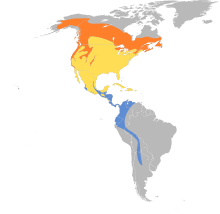Swainson's thrush
| Swainson's thrush | |
|---|---|

| |
| Scientific classification | |
| Domain: | Eukaryota |
| Kingdom: | Animalia |
| Phylum: | Chordata |
| Class: | Aves |
| Order: | Passeriformes |
| Family: | Turdidae |
| Genus: | Catharus |
| Species: | C. ustulatus
|
| Binomial name | |
| Catharus ustulatus (Nuttall, 1840)
| |

| |
| Synonyms | |
|
Hylocichla swainsonii | |
Swainson's thrush (Catharus ustulatus), also called olive-backed thrush and russet-backed thrush, is a medium-sized
Etymology
The genus name Catharus comes from the Ancient Greek katharos, "pure or clean" and refers to the plumage of the orange-billed nightingale-thrush C. aurantiirostris. The specific ustulatus is Latin for "burnt", from urere, "to burn".[2]
Habitat
The breeding
Range and distribution
These birds migrate to southern Mexico and as far south as Argentina. The coastal subspecies migrate down the Pacific coast of North America and winter from Mexico to Costa Rica, whereas the continental birds migrate eastwards within North America (a substantial detour) and then travel southwards via Florida to winter from Panama to Bolivia. Swainson's thrush is a very rare vagrant to western Europe. It has also occurred as a vagrant in northeast Asia.[3]
Threats
This section includes a improve this section by introducing more precise citations. (December 2023) ) |
This species may be displaced by the hermit thrush where their ranges overlap. Possibly, the latter species adapts more readily to human encroachment upon its habitat. At least in the winter quarters, Swainson's thrush tends to keep away from areas of human construction and other activity.
Description
This species is 16–20 cm (6.3–7.9 in) in length. The wingspan averages at 30 cm (12 in) and the wing chord is 8.7–10.5 cm (3.4–4.1 in). The bill measures 1.5–1.9 cm (0.59–0.75 in) in length and the tarsus is 2.5 to 3.1 cm (0.98 to 1.22 in) long. This species' body mass can range from 23 to 45 g (0.81 to 1.59 oz).[4][5][6] This thrush has the white-dark-white underwing pattern characteristic of Catharus thrushes. Adults are brown on the upperparts. The underparts are white with brown on the flanks; the breast is lighter brown with darker spots. They have pink legs and a light brown eye ring. Birds in the east are more olive-brown on the upperparts; western birds are more reddish brown. This bird's song is a hurried series of flute-like tones spiralling upwards.
Diet
They forage on the forest floor, also in trees.[7] Swainson's thrushes mainly eat insects, fruits and berries.[8] They make a cup nest on a horizontal tree branch.
Subspecies
Four subspecies are recognised, Cathartus ustulatus alame, C. u. swainsoni, C. u. ustulatus and C. u. oedicus. Subspecies Cathartus ustulatus alame and C. u. swainsoni summer east of the
The genetic differences between the subspecies, and the circuitous migratory route of the continental birds, strongly suggest that these species underwent a rapid range expansion following the end of the last ice age, with populations originally summering in the south-east of North America expanding their ranges northwards and westwards as the ice retreated. Details of the molecular genetic analysis support the hypothesis of rapid expansion of both coastal and continental populations. The current migratory routes of the continental birds, especially the western populations, are not optimal in ecological terms, and presumably represent an inherited, historical route pattern that has not yet adapted to the birds' modern population locations.
These results notwithstanding, analysis of
Gallery
-
Swainson's thrush on South Padre Island, Texas
-
On South Padre Island, Texas
-
A Swainson's thrush in British Columbia
Footnotes
- . Retrieved 18 November 2021.
- ISBN 978-1-4081-2501-4.
- ISBN 978-0-7136-7040-0page 402
- ^ "Swainson's Thrush".
- ^ "eNature: FieldGuides: Species Detail". Archived from the original on 2012-03-05.
- ISBN 978-0-691-08852-5
- S2CID 55499980.)
{{cite journal}}: CS1 maint: multiple names: authors list (link - ^ Out of the wide range of fruit eaten by this bird, those of Cymbopetalum mayanum (Annonaceae) and especially Trophis racemosa (Moraceae) are well-liked whenever available in the winter quarters. However, they are generally not taken from feeders or disturbed habitat: Foster (2007)
- ^ Ruegg & Smith (2002)
- ^ Winker & Pruett (2006)
References
- Foster, Mercedes S. (2007): "The potential of fruiting trees to enhance converted habitats for migrating birds in southern Mexico." Bird Conservation International 17(1): 45–61.
- Ruegg, K. C., & Smith, T.B. (2002). "Not as the crow flies: a historical explanation for circuitous migration in Swainson's thrush (Catharus ustulatus)."
- Winker, Kevin & Pruett, Christin L. (2006): "Seasonal migration, speciation, and morphological convergence in the avian genus Catharus (Turdidae)." DOI: 10.1642/0004-8038(2006)123[1052:SMSAMC]2.0.CO;2 PDF fulltext]
External links
- Swainson's Thrush Species Account - Cornell Lab of Ornithology
- Swainson's Thrush - Catharus ustulatus - USGS Patuxent Bird Identification InfoCenter
- Examples of Turdidae Thrush calls - naturesongs.com
- "Swainson's thrush media". Internet Bird Collection.
- Swainson's thrush photo gallery at VIREO (Drexel University)
- Interactive range map of Catharus ustulatus at IUCN Red List maps




